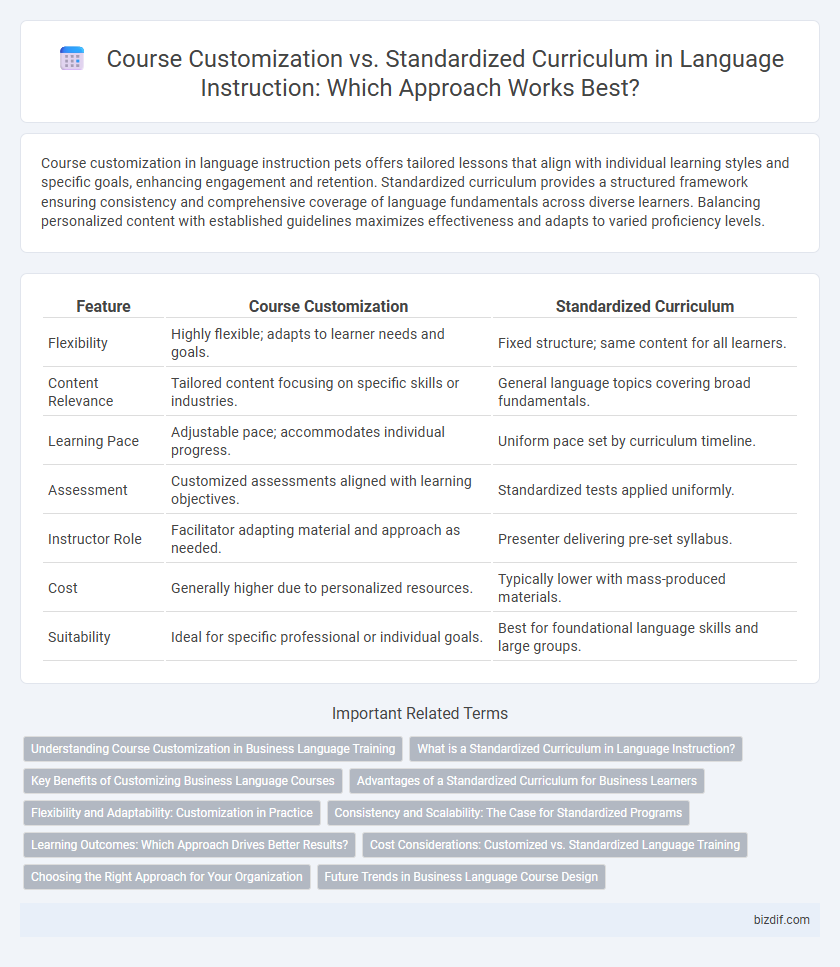Course customization in language instruction pets offers tailored lessons that align with individual learning styles and specific goals, enhancing engagement and retention. Standardized curriculum provides a structured framework ensuring consistency and comprehensive coverage of language fundamentals across diverse learners. Balancing personalized content with established guidelines maximizes effectiveness and adapts to varied proficiency levels.
Table of Comparison
| Feature | Course Customization | Standardized Curriculum |
|---|---|---|
| Flexibility | Highly flexible; adapts to learner needs and goals. | Fixed structure; same content for all learners. |
| Content Relevance | Tailored content focusing on specific skills or industries. | General language topics covering broad fundamentals. |
| Learning Pace | Adjustable pace; accommodates individual progress. | Uniform pace set by curriculum timeline. |
| Assessment | Customized assessments aligned with learning objectives. | Standardized tests applied uniformly. |
| Instructor Role | Facilitator adapting material and approach as needed. | Presenter delivering pre-set syllabus. |
| Cost | Generally higher due to personalized resources. | Typically lower with mass-produced materials. |
| Suitability | Ideal for specific professional or individual goals. | Best for foundational language skills and large groups. |
Understanding Course Customization in Business Language Training
Course customization in business language training tailors content to specific industry jargon, communication scenarios, and company goals, enhancing learner relevance and engagement. Unlike standardized curricula, customized courses address unique organizational needs, promoting practical application and measurable skill development. This targeted approach improves employee performance and supports strategic business outcomes through specialized language proficiency.
What is a Standardized Curriculum in Language Instruction?
A standardized curriculum in language instruction consists of a fixed set of learning objectives, materials, and assessment methods designed to be used uniformly across different classrooms and learners. It ensures consistency in language proficiency benchmarks and facilitates the systematic evaluation of student progress. This approach allows educational institutions to maintain quality control and align instruction with national or international language standards.
Key Benefits of Customizing Business Language Courses
Customizing business language courses enhances learner engagement by tailoring content to specific industry vocabulary and real-world scenarios, resulting in faster skill acquisition and higher retention rates. Personalized instruction addresses individual proficiency levels and cultural nuances, improving communication effectiveness within global teams. Tailored courses also enable organizations to align language training with strategic goals, boosting overall productivity and competitive advantage.
Advantages of a Standardized Curriculum for Business Learners
A standardized curriculum provides business learners with consistent and measurable learning outcomes, ensuring all participants acquire essential industry terminology and communication skills. This uniform approach allows multinational companies to implement training programs efficiently across diverse locations while maintaining quality and coherence. Standardized courses also facilitate easier assessment, certification, and comparison of learners' proficiency levels, supporting career advancement in global business environments.
Flexibility and Adaptability: Customization in Practice
Course customization offers unparalleled flexibility, allowing language instruction to be tailored to individual learner needs, goals, and proficiency levels. Unlike standardized curriculums, customized courses adapt dynamically to diverse learning styles, pacing, and cultural backgrounds, enhancing engagement and retention. This adaptability supports targeted skill development and real-time feedback integration, optimizing language acquisition outcomes.
Consistency and Scalability: The Case for Standardized Programs
Standardized language instruction programs ensure consistency in learning outcomes by delivering uniform content and assessment methods across all classes. This consistency facilitates scalable implementation, making it easier for institutions to train multiple instructors and expand enrollment without compromising quality. Standardized curricula leverage proven frameworks and materials, enabling efficient resource allocation and streamlined course management.
Learning Outcomes: Which Approach Drives Better Results?
Course customization in language instruction tailors content and pacing to individual learner needs, often resulting in higher engagement and improved language retention. Standardized curriculums offer consistency and clear benchmarks but may lack flexibility to address diverse learning styles and proficiency levels. Research indicates that personalized learning paths within customized courses frequently lead to superior communication skills and greater learner satisfaction compared to one-size-fits-all programs.
Cost Considerations: Customized vs. Standardized Language Training
Customized language training often incurs higher costs due to the tailored materials, specialized instructors, and individualized pacing required to meet specific learner needs. In contrast, standardized curricula benefit from economies of scale, utilizing pre-developed content and uniform assessments that lower overall expenses. Organizations must balance budget constraints with training effectiveness when choosing between customized and standardized language instruction options.
Choosing the Right Approach for Your Organization
Selecting between course customization and a standardized curriculum depends on organizational goals, learner diversity, and resource availability. Customized courses offer flexibility to address specific skill gaps and cultural nuances, enhancing learner engagement and retention. Standardized curricula ensure consistency in content delivery and assessment, supporting scalability and comparability across large or diverse learner groups.
Future Trends in Business Language Course Design
Future trends in business language course design emphasize adaptive course customization over standardized curricula, integrating AI-driven analytics to tailor content to individual learner needs and industry demands. Emphasis on flexible modules enables companies to address specific communication skills relevant to evolving market sectors such as technology, finance, and international trade. This shift enhances learner engagement and improves practical language application, fostering quicker proficiency aligned with corporate objectives.
Course Customization vs Standardized Curriculum Infographic

 bizdif.com
bizdif.com